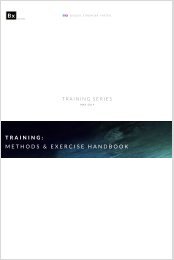You also want an ePaper? Increase the reach of your titles
YUMPU automatically turns print PDFs into web optimized ePapers that Google loves.
HTKSPORT<br />
#5 BIG + FAST<br />
E X P L O S I V E S I Z E & S P E E D<br />
D E S C R I P T I O N<br />
This training goal focuses on getting faster while<br />
building muscle. Speed-specific hypertrophy should<br />
focus on frequently programmed, high intensity<br />
isometrics (recruitment focused) mixed with power<br />
training and speed training leading into peaking<br />
periods. Non-speed specific hypertrophy (such as<br />
upper body muscle for 'leg speed' athletes) can<br />
follow more traditional upper body hypertrophy<br />
methods performed alongside power/speed phases.<br />
G O A L S<br />
Strength<br />
Strength-Speed<br />
Speed-Strength<br />
Power<br />
Speed<br />
Hypertrophy<br />
Upper body size/strength + explosive glutes<br />
and hips = Big & Fast<br />
Generally speaking, collision sport athletes that are looking for explosiveness and size want<br />
upper body size/strength and powerful/explosive hips and legs. Increased CSA in legs can<br />
interfere with mobility, particularly during the back-side action of the leg recovery phase; this<br />
will reduce the acceleration of the leg (and hence force production) by preventing the leg lever<br />
shortening fully (heel to glute) – a longer lever is slower to move. Therefore upper body<br />
training can focus on the hypertrophy/strength end of the size and speed continuum, while<br />
lower body focuses on the power/explosiveness end of the size and speed continuum. Ideally<br />
you don’t want upper body size and strength work to interfere with recovery or performance of<br />
speed work. Examples of speed work include sprints, sled work, hill sprints, footwork/’fastfeet’,<br />
sport-specific drills, plyometrics, isometrics and RFD exercises. Speed-specific<br />
hypertrophy work includes functional HISD isometrics, long duration isometrics. Non-speed<br />
specific hypertrophy includes traditional higher rep weight lifting, long duration isometrics and<br />
blood flow training (‘pump’ sets).<br />
U P P E R B O D Y S I Z E / S T R E N G T H + E X P L O S I V E H I P S &<br />
L E G S<br />
P O W E R B A S E S P E E D H Y P E R T R O P H Y<br />
WORKOUT A (Speed-Strength)<br />
WORKOUT A<br />
WORKOUT A<br />
FREQUENT Contains priority power training elements;<br />
trained frequently<br />
POWER / RATE Neuro-muscular input is ‘peak power’ or<br />
maximal velocity/rate<br />
REPS Set duration is either 0-9secs, or 10 – 25secs<br />
SETS Set number depends on desired fatigue/recovery time<br />
(autoregulation), and power outcome focus (performance<br />
vs. capacity)<br />
FOCUS Should be max effort (performance), measured by<br />
load/time/reps or technique drop off<br />
WORKOUT B (Strength-Speed)<br />
INFREQUENT Contains conjugate power training elements;<br />
trained infrequently<br />
SUSTAINED Neuro-muscular input is sustained contraction<br />
REPS Set duration is either 0-9secs, or 10 – 25secs<br />
SETS Set number depends on desired fatigue/recovery time<br />
(autoregulation) - should be greater fatigue protocol than<br />
WORKOUT A..<br />
FOCUS Focus should be max effort (performance), or<br />
strength capacity (prime/capacity) measured by<br />
load/time/reps drop off<br />
FREQUENT Contains priority speed training elements;<br />
trained frequently<br />
EXPLOSIVE / RATE Neuro-muscular input is ‘explosive<br />
power’ or maximal velocity/rate<br />
SETS Set duration is 0-9secs<br />
REPS Set number depends on desired fatigue/recovery time<br />
(autoregulation), and power outcome focus (performance<br />
vs. capacity)<br />
FOCUS Should be max effort (pinnacle / performance)<br />
measured by time or technique drop off<br />
WORKOUT B<br />
INFREQUENT Contains conjugate speed training<br />
elements; trained infrequently.<br />
POWER Neuro-muscular input is ‘peak power’<br />
REPS Set duration is either 0-9secs<br />
SETS Set number depends on desired fatigue/recovery time<br />
(autoregulation) - should be greater fatigue protocol than<br />
WORKOUT A<br />
FOCUS Should be max effort ('pinnacle' / performance),<br />
measured by time or technique drop off<br />
FREQUENT Contains priority hypertrophy training<br />
elements; trained frequently<br />
SUSTAINED Neuro-muscular input is sustained<br />
contraction<br />
SETS Set duration is either 25-40secs, or 40 – 75secs<br />
REPS Set number depends on desired fatigue/recovery time<br />
(autoregulation)<br />
FOCUS Should be on contractile capacity (capacity),<br />
measured by load/time/reps drop off<br />
WORKOUT B<br />
INFREQUENT Contains conjugate hypertrophy training<br />
elements; trained infrequently.<br />
POWER Neuro-muscular input is ‘peak power'<br />
REPS Set duration is either 0-9secs, or 10 - 25secs<br />
SETS Set number depends on desired fatigue/recovery time<br />
(autoregulation) - should be greater fatigue protocol than<br />
WORKOUT A<br />
FOCUS Should be on power capacity ('prime' / capacity),<br />
measured by time or technique drop off<br />
65<br />
JULY 2018 | ISSUE 01<br />
Workout progression should be either AAAB or AAAAB. See next page for a full program progression for every<br />
Athlete Type




